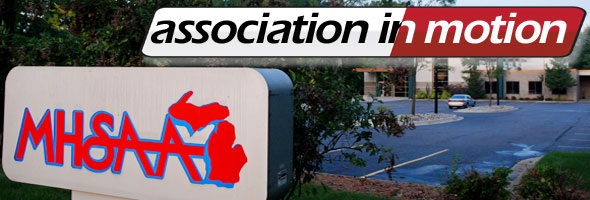
Study: Single-Sport Athletes Injured More
November 3, 2016
A study conducted by the University of Wisconsin School of Medicine and Public Health and funded by the National Federation of State High School Associations (NFHS) Foundation revealed that high school athletes who specialize in a single sport sustain lower-extremity injuries at significantly higher rates than athletes who do not specialize in one sport.
The study was conducted throughout the 2015-16 school year at 29 high schools in Wisconsin involving more than 1,500 student-athletes equally divided between male and female participants. The schools involved in the study represented a mixture of rural (14), suburban (12) and urban (3) areas, and enrollments were equally diverse with 10 small schools (less than 500 students), 10 medium schools (501-1,000 students) and nine large schools (more than 1,000 students).
Athletes who specialized in one sport were twice as likely to report previously sustaining a lower-extremity injury while participating in sports (46%) than athletes who did not specialize (24%). In addition, specialized athletes sustained 60 percent more new lower-extremity injuries during the study than athletes who did not specialize. Lower-extremity injuries were defined as any acute, gradual, recurrent or repetitive-use injury to the lower musculoskeletal system.
“While we have long believed that sport specialization by high school athletes leads to an increased risk of overuse injury, this study confirms those beliefs about the potential risks of sport specialization,” said Bob Gardner, NFHS executive director. “Coaches, parents and student-athletes need to be aware of the injury risks involved with an overemphasis in a single sport.”
Among those who reported previously sustaining a lower-extremity injury, the areas of the body injured most often were the ankle (43%) and knee (23%). The most common types of previous injuries were ligament sprains (51%) and muscle/tendon strains (20%).
New injuries during the year-long study occurred most often to the ankle (34%), knee (25%) and upper leg (13%), with the most common injuries being ligament sprains (41%), muscle/tendon strains (25%) and tendonitis (20%).
In addition, specialized athletes were twice as likely to sustain a gradual onset/repetitive-use injury than athletes who did not specialize, and those who specialized were more likely to sustain an injury even when controlling for gender, grade, previous injury status and sport.
Thirty-four (34) percent of the student-athletes involved in the Wisconsin study specialized in one sport, with females (41%) more likely to specialize than males (28%). Soccer had the highest level of specialization for both males (45%) and females (49%). After soccer, the rate of specialization for females was highest for softball (45%), volleyball (43%) and basketball (37%). The top specialization sports for males after soccer were basketball (37%), tennis (33%) and wrestling (29%).
The study, which was directed by Timothy McGuine, Ph.D., ATC, of the University of Wisconsin, also documented the effects of concurrent sport participation (participating in an interscholastic sport while simultaneously participating in an out-of-school club sport), which indicated further risk of athletes sustaining lower-extremity injuries.
Almost 50 percent of the student-athletes involved in the survey indicated they participated on a club team outside the school setting, and 15 percent of those individuals did so while simultaneously competing in a different sport within the school. Seventeen (17) percent of the student-athletes indicated that they took part in 60 or more primary sport competitions (school and club) in a single year. Among those student-athletes in this group who sustained new lower-extremity injuries during the year, 27 percent were athletes who specialized in one sport.
The student-athletes involved in the study were deemed “specialized” if they answered “yes” to at least four of the following six questions: 1) Do you train more than 75 percent of the time in your primary sport?; 2) Do you train to improve skill and miss time with friends as a result?; 3) Have you quit another sport to focus on one sport?; 4) Do you consider your primary sport more important than your other sports?; 5) Do you regularly travel out of state for your primary sport?; 6) Do you train more than eight months a year in your primary sport?
Although some sports (field hockey, lacrosse) are not offered in Wisconsin and were not included in the study, the study concluded that since specialization increased the risk of lower-extremity injuries in sports involved in the survey it would also likely increase the risk of injuries in sports that were not a part of the study.

Multi-Sport Participation Holds Steady in 2023-24, Continuing Increases Found Over Entirety of Study
By
Geoff Kimmerly
MHSAA.com senior editor
January 16, 2025
The MHSAA’s sixth Multi-Sport Participation Survey, conducted last spring for the 2023-24 school year, showed for the third-consecutive year that nearly 45 percent of athletes at member high schools participated in more than one sport, while the entirety of the study continues to show that percentages of multi-sport athletes for all four Classes (A-B-C-D) have grown during the six years this topic has been studied in this way.
Early and intense sport specialization has become one of the most serious issues related to health and safety at all levels of youth sports, as overuse injuries and burnout among athletes have been tied to chronic injuries and health-related problems later in life. In early 2016, the MHSAA appointed a Task Force on Multi-Sport Participation as part of a continued effort to promote and protect participant health and address the issues leading to early sport specialization. The annual Multi-Sport Participation Survey was among results of the task force’s work.
The 2023-24 Multi-Sport Participation Survey received responses from 63.7 percent of member high schools and showed 44.8 percent of athletes at those MHSAA member high schools participating in two or more sports, a tenth of a percent increase from survey results in 2022-23 and half a percent increase from two years prior.
For 2023-24, 47.6 percent of male athletes and 41.4 percent of female athletes played multiple sports. Class D has enjoyed the highest percentage of multi-sport athletes over all six years of surveys, this time at 63.1 percent, followed by Class C (59.4), Class B (48.0) and Class A (38.2).
Over the six years of this survey, data also has shown slight increases in multi-sport participation in all four classes. Class A has risen from 35.9 percent in 2017-18 to 38.2 in 2023-24. Class B has risen from 46.7 to 48.0, Class C from 55.2 to 59.4 and Class D from 58.1 to 63.1 over those six years.
The MHSAA Task Force also recommended measuring multi-sport participation in MHSAA member schools to recognize “achievers” – that is, schools that surpass the norm given their enrollment and other factors that affect school sports participation.
Battle Creek Harper Creek, Detroit Cody and Grand Rapids Northview have appeared among the top 10 percent of their respective Classes five of the six years the survey has been conducted. Five more schools have appeared among the top 10 percent of their Classes four of the six years: Decatur, East Grand Rapids, Manton, Parma Western and Warren Michigan Collegiate.
In Class A, Macomb L’Anse Creuse North (94.7 percent) and Battle Creek Harper Creek (72.4) posted the highest percentages of multi-sport athletes for 2023-24, with Grand Rapids Northview (68.1), Berkley (65.0) and Kalamazoo Loy Norrix (64.3) also reporting reaching at least 60 percent. In Class B, four schools reached at least 65 percent multi-sport participation – Parma Western (78.0), Constantine (75.4), Clare (65.7) and Reed City (65.4).
Class C saw six schools reach 80 percent this past school year – Warren Michigan Collegiate (91.7 percent), Flint Beecher (91.3), LeRoy Pine River (89.5), Cass City (84.3), Decatur (83.3) and Manton (81.4). Four Class D schools responded at higher than 90 percent multi-sport participation – Gaylord St. Mary (92.9), Lake Leelanau St. Mary (91.7), Wyoming West Michigan Lutheran (90.9) and Deckerville (90.7) – followed by Marcellus Howardsville Christian (88.9), Morrice (86.8), Ewen-Trout Creek (85.7), Vestaburg (85.5) and Alanson (85.0).
Click for the full summary report on the Multi-Sport Participation Survey.

